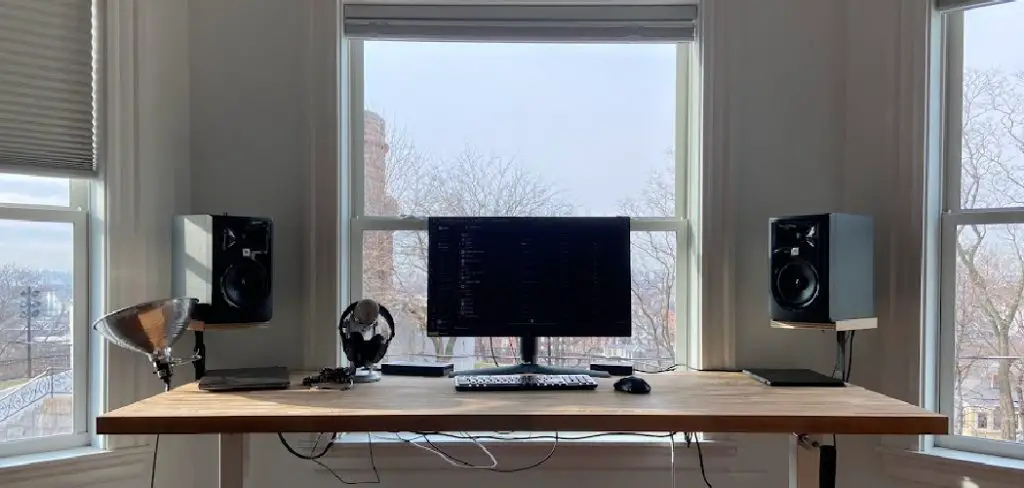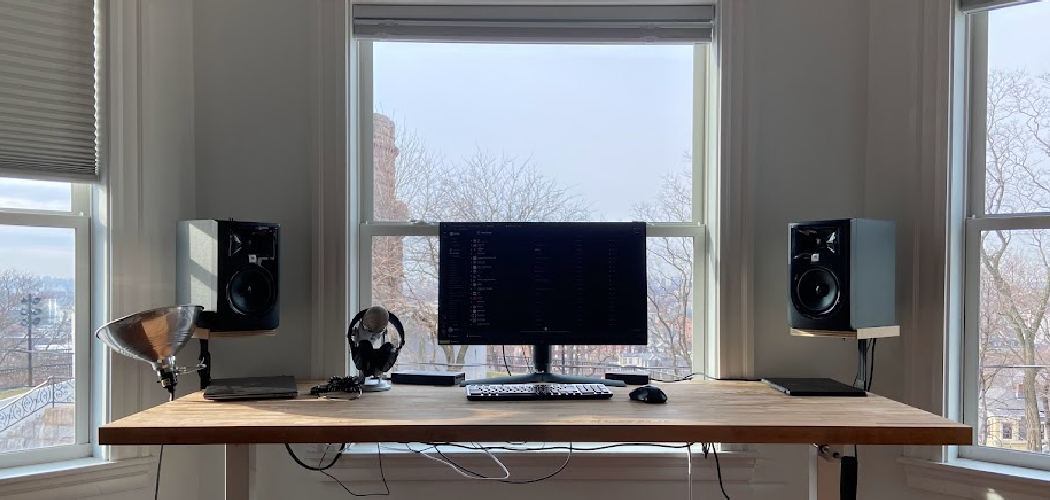Setting the correct height for an adjustable desk is crucial for creating a comfortable and ergonomic workspace. Whether you have just acquired a new adjustable desk or are looking to optimize your existing one, understanding how to properly set the desk height is essential. By achieving the correct desk height, you can alleviate strain on your body, improve posture, and enhance productivity. In this article, we will explore the step-by-step process of how to set adjustable desk height to ensure a customized and ergonomic working environment.

We will discuss various factors to consider, such as your seated and standing heights, monitor placement, and proper alignment of your arms and wrists. By following these guidelines, you will be able to optimize your desk height and create a workspace that promotes comfort, health, and overall well-being.
The Importance of Ergonomic Desk Setup
When sitting at a desk for hours on end, ergonomics is an important factor to consider. Making sure your desk setup is ergonomic can help improve productivity, reduce fatigue, and even prevent work-related injuries.
An adjustable-height desk allows you to easily customize the position of your workspace so that it meets your specific needs. Sitting too low or too high can cause tension in your shoulders, neck, and back, so having the ability to adjust your desk height helps you maintain a comfortable sitting posture.
Adjusting the height of your workspace can also help improve circulation in your legs and feet, promote better eye contact and visibility when engaging with coworkers, and reduce strain on your wrists from typing or using a mouse.
Not all adjustable desks are created equal, though. It’s important to choose one that is sturdy enough for daily use and allows you to make adjustments easily without tools. With the right ergonomic setup, you’ll be able to work more comfortably and efficiently throughout the day.
Benefits of an Adjustable Desk Height
One of the greatest benefits to having an adjustable desk height is the ability to customize your workspace to better suit your needs. Whether you are looking for a more comfortable sitting position, or want to switch between standing and sitting throughout the day, having an adjustable desk can help make it happen.
An adjustable desk also provides a range of health benefits since it allows for easy switching between different postures. By being able to tailor your workspace to different heights, you can reduce back strain and fatigue that often come with long periods of sitting or standing at one height all day. Studies have also shown that alternating between postures helps improve overall productivity and mental well-being in the workplace.

Another benefit of an adjustable desk is the ability to reduce strain and discomfort associated with neck and wrist pain. Adjustable desks allow for a more ergonomic workspace which eliminates awkward positioning while typing or mouse clicking, as you can set your desk height to the desired level.
Lastly, adjustable desk heights are an economical choice for businesses who want to provide their employees with various options for their workspace, without having to invest in multiple desks. An adjustable desk can be adjusted to suit any user quickly and easily, no matter their size or height.
10 Steps How to Set Adjustable Desk Height
Step 1: Assess Your Seated Height
Begin by adjusting your chair to a comfortable and proper seated height. Sit with your feet flat on the floor and your knees at a 90-degree angle. Measure the distance between the floor and the underside of your thigh.
This measurement will serve as a reference point when determining the desk height. However, if you need to customize your desk for a standing height, the same process still applies. Try to maintain a similar 90-degree knee angle.
Step 2: Determine the Ideal Desk Height for Seated Work
To establish the proper desk height for seated work, use the measurement obtained in Step 1. Add this measurement to the height of your forearm from the floor when your elbow is bent at a 90-degree angle.
This total height will help you determine the ideal desk height for seated tasks. You may also want to consider the height of your chair and adjust the desk accordingly. Though it may be necessary to adjust your chair or desk height during the day, setting the right initial height can help you maintain good posture and ergonomic positioning.
Step 3: Adjust the Desk Height for Seated Work
Using the information obtained in Step 2, adjust your adjustable desk to the determined height. Follow the manufacturer’s instructions for adjusting the desk height. Ensure that the desk is level and stable after making the necessary adjustments.
Once the desk is at the correct height, make sure that it’s comfortable to sit in. Whether you’re seated or standing, your posture should be upright and relaxed. Your wrists should also remain in a neutral position, as typing on a keyboard at an angle can lead to discomfort and injury. Make sure that the desk surface is not too high or low for your arms to comfortably rest on it.

Step 4: Assess Your Standing Height
Evaluate your standing height by standing with your feet shoulder-width apart and your arms hanging naturally by your sides. Measure the distance between the floor and the height of your elbow when bent at a 90-degree angle. This measurement will aid in determining the appropriate desk height for standing work.
Step 5: Determine the Ideal Desk Height for Standing Work
To establish the proper desk height for standing work, use the measurement obtained in Step 4. Add this measurement to the height of your forearm from the floor when your elbow is bent at a 90-degree angle. This total height will help you determine the ideal desk height for standing tasks.
Step 6: Adjust the Desk Height for Standing Work
Using the information obtained in Step 5, adjust your adjustable desk to the determined height for standing work. Follow the manufacturer’s instructions for adjusting the desk height. Ensure that the desk is level and stable after making the necessary adjustments. Once the desk is at the correct height, you are ready to do your standing work.
When it comes time to switch between sitting and standing, using an adjustable desk makes it easy to make the transition. Simply adjust the height of the desk to match your desired sitting or standing position, and you are ready to get back to work. Adjustable desks provide a flexible workspace that allows you to switch between sitting and standing throughout the day.
Step 7: Consider Monitor Placement
Proper monitor placement is vital for maintaining good posture and minimizing strain on the neck and eyes. Position your monitor at eye level, approximately an arm’s length away from your face. Adjust the monitor height and tilt to achieve optimal viewing angles.
If you use multiple monitors, be sure to adjust each monitor individually. You may also need to adjust the height of your keyboard and mouse to maintain comfort and reduce strain.
Step 8: Align Your Arms and Wrists
Ensure that your arms and wrists are properly aligned to prevent discomfort and strain. When seated, your forearms should rest parallel to the desk surface, with your wrists in a neutral position.
Adjust the desk height or use an ergonomic keyboard tray to achieve proper alignment. If needed, use a wrist rest to support your wrists. When standing, adjust the desk height so that the keyboard is at elbow level, and follow the same principles of neutral wrist positioning.

Step 9: Make Fine Adjustments
Once you have set the initial desk height for seated and standing work, spend some time working at your desk in both positions. Pay attention to any discomfort or strain and make fine adjustments to the desk height as needed.
Everyone’s body is different, so it’s important to find the height that feels most comfortable for you. If you share the desk with someone else, make sure to adjust the height separately for each person.
Step 10: Regularly Reassess and Modify
As your body and needs may change over time, it is essential to regularly reassess and modify your desk height. Factors such as changes in footwear, weight, or overall health may influence the ideal desk height for you.
Stay attentive to your body’s signals and make adjustments accordingly to maintain an ergonomic workspace. By following the steps above and consistently reassessing and modifying your desk setup, you can ensure that you have an ergonomic workspace that will keep you comfortable and productive.

Conclusion
Setting the adjustable desk height correctly is essential for creating an ergonomic and comfortable workspace. By following these steps on how to set adjustable desk height, you can ensure that your desk is properly adjusted for both seated and standing work, allowing you to maintain good posture and reduce strain on your body.
Remember to consider factors such as seated and standing heights, monitor placement, and alignment of your arms and wrists. Regularly reassess and modify your desk height as needed to accommodate changes in your body and maintain an optimal working environment.

